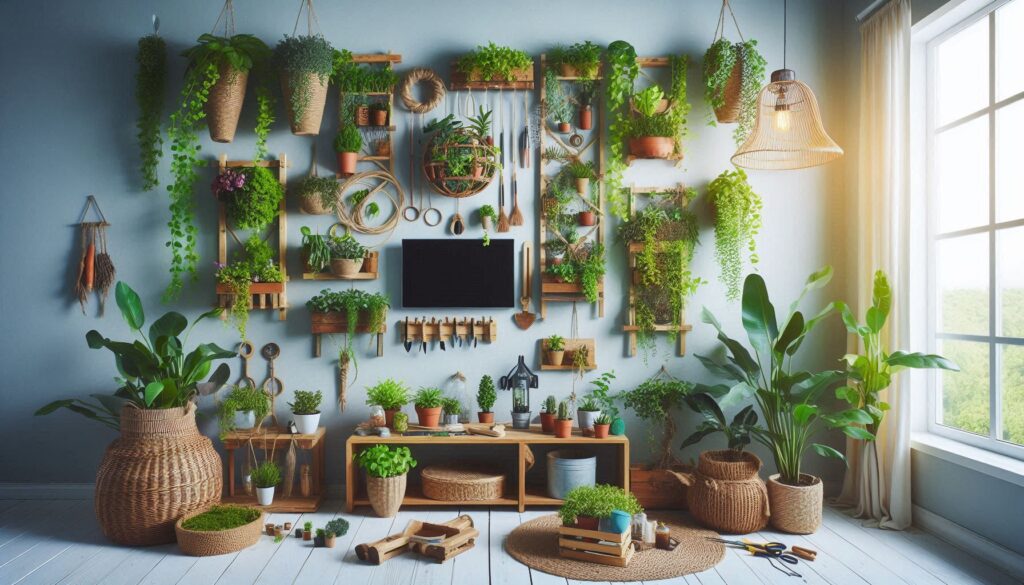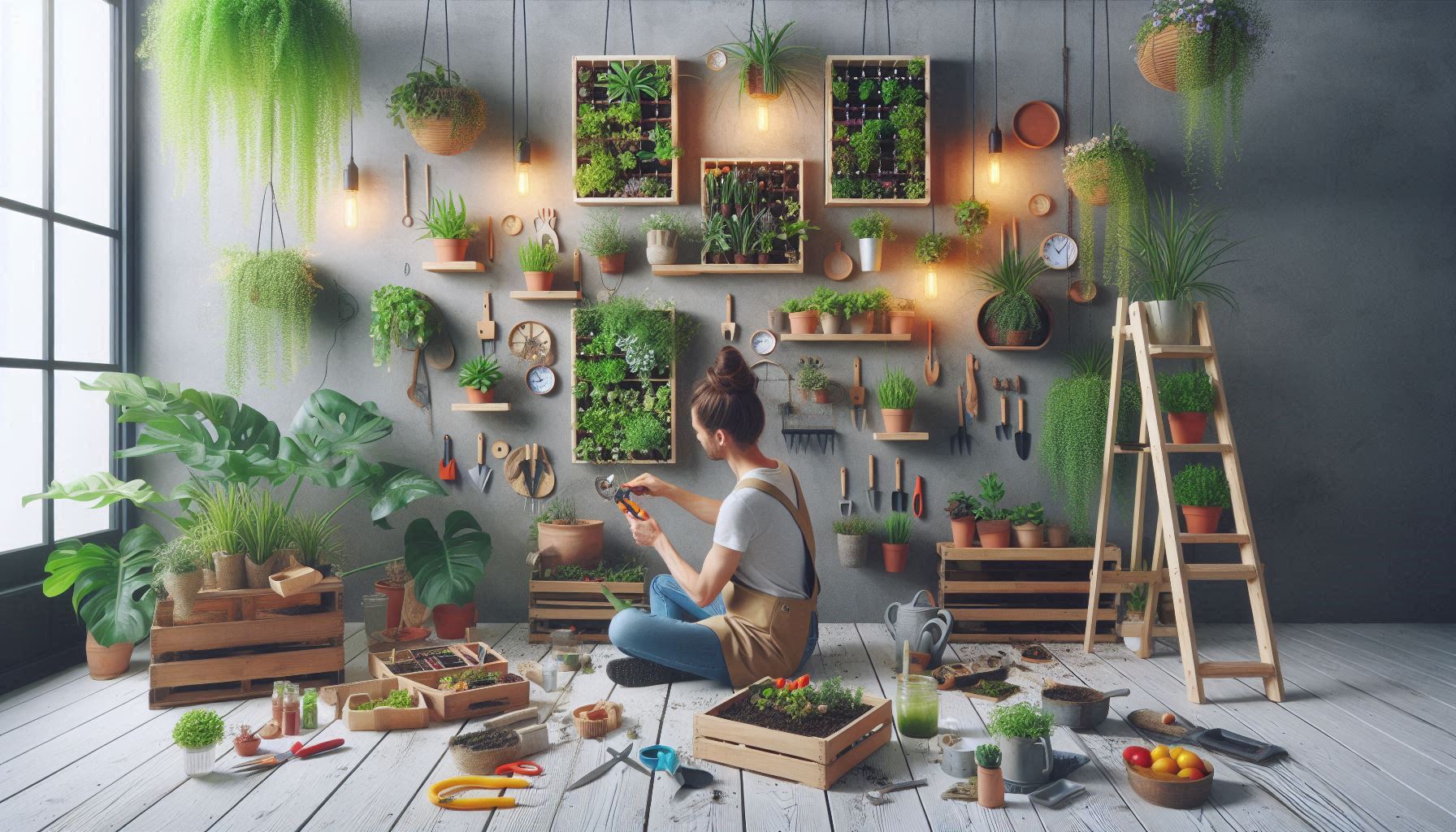Vertical gardening is a growing trend that allows you to cultivate plants in a vertical space, making it an ideal solution for urban dwellers with limited outdoor space. Whether you want to add greenery to your apartment balcony, patio, or indoor living space, vertical gardens offer a creative and versatile way to bring nature into your surroundings. In this article, we will explore DIY vertical gardening projects for beginners, providing step-by-step instructions, tips, and inspiration to help you create your own vertical garden oasis.
Chapter 1: Getting Started with Vertical Gardening
Before diving into DIY vertical gardening projects, it’s essential to understand the basics of vertical gardening and how to get started. Here are some key considerations for beginners:
- Selecting a Location: Choose a suitable location for your vertical garden based on factors such as sunlight exposure, space availability, and access to water. Consider areas that receive sufficient sunlight for your plants’ needs and where you can easily water and maintain your vertical garden.
- Choosing Plants: Select plants that are well-suited for vertical growth, such as vining plants, succulents, ferns, herbs, and flowering plants. Consider the light conditions, climate, and maintenance requirements of each plant to ensure successful growth in your vertical garden.
- Container Selection: Decide on the type of containers or planters you will use for your vertical garden. Options include wall-mounted planters, hanging baskets, vertical garden kits, pallet planters, and repurposed containers such as mason jars or shoe organizers. Choose containers that are appropriate for the size and weight of your plants.
- Soil and Drainage: Use a well-draining potting mix for your vertical garden to prevent waterlogging and promote healthy plant growth. Ensure that your containers have adequate drainage holes or incorporate a drainage layer of gravel or perlite to maintain proper soil moisture.
Chapter 2: DIY Vertical Garden Projects for Beginners

Now that you have prepared the basics for your vertical garden, let’s explore some easy and creative DIY vertical gardening projects for beginners:
Hanging Herb Garden:
Materials Needed:
- Wooden or metal hanging planter
- Herb plants (such as basil, mint, parsley)
- Potting mix
- Watering can
Instructions:
- Fill the hanging planter with potting mix, leaving some space at the top for planting.
- Arrange the herb plants in the planter, spacing them evenly and ensuring they have room to grow.
- Water the plants thoroughly and hang the planter in a sunny location where the herbs can receive adequate sunlight.
- Maintain the herb garden by watering regularly and harvesting herbs as needed for cooking or seasoning.
Pallet Vertical Garden:
Materials Needed:
- Wooden pallet
- Landscaping fabric
- Staple gun
- Potting mix
- Plants of your choice
Instructions:
- Lay the pallet flat on the ground and cover the back and sides with landscaping fabric, securing it with a staple gun.
- Fill the spaces between the pallet slats with potting mix, pressing it firmly into place.
- Plant your choice of plants in the pockets created by the slats, allowing room for growth and regular watering.
- Stand the pallet upright against a wall or fence in a sunny location and water the plants as needed to keep the soil moist.
Vertical Succulent Garden:
Materials Needed:
- Vertical succulent planter or frame
- Succulent plants (such as aeoniums, sedums, echeverias)
- Cactus potting mix
- Spray bottle for watering
Instructions:
- Arrange the succulent plants in the planter or frame, spacing them evenly and selecting a variety of shapes and colors for visual interest.
- Fill the planting pockets with cactus potting mix, gently pressing the soil around the plants to secure them in place.
- Water the succulents lightly using a spray bottle, being careful not to overwater and avoid wetting the leaves.
- Display the vertical succulent garden in a bright location with indirect sunlight and enjoy the unique beauty of these low-maintenance plants.
Hanging Basket Vertical Garden:
Materials Needed:
- Hanging baskets
- Coconut coir liners
- Potting mix
- Flowering plants (such as petunias, fuchsias, geraniums)
- Watering can
Instructions:
- Line the hanging baskets with coconut coir liners, creating a base for the potting mix and plants.
- Fill the baskets with potting mix, leaving space for planting the flowering plants and allowing for drainage.
- Plant the flowering plants in the baskets, arranging them in a pleasing design and ensuring they have room to grow.
- Water the plants thoroughly and hang the baskets in a sunny location where they can receive ample sunlight for blooming.
Chapter 3: Tips for Maintaining Your Vertical Garden
Now that you have completed your DIY vertical gardening projects, it’s essential to maintain and care for your vertical garden to ensure the health and vitality of your plants. Here are some tips for maintaining your vertical garden:
- Watering: Monitor the moisture levels of your vertical garden regularly and water your plants as needed. Check the soil moisture by inserting your finger into the soil, and water thoroughly if it feels dry to the touch. Adjust your watering frequency based on the plant’s requirements and environmental conditions.
- Fertilizing: Provide nutrients to your plants by fertilizing them regularly with a balanced plant food or organic fertilizer. Follow the instructions on the fertilizer package for the correct dosage and frequency to promote healthy growth and blooming.
- Pruning and Grooming: Keep your vertical garden plants tidy and healthy by pruning dead or yellowing leaves, flowers, or stems. Regularly groom vining plants by removing excessive growth or training them to climb and cascade in the desired direction.
- Pest and Disease Management: Monitor your plants for signs of pests, such as aphids, spider mites, or mealybugs, and take prompt action to control infestations. Use natural or chemical-free pest control methods to protect your plants while minimizing harm to beneficial insects.
- Light Requirements: Ensure that your plants are receiving adequate light for healthy growth and development. Position your vertical garden in a sunny location where plants can receive the amount of sunlight required for their specific needs. Adjust the positioning of your vertical garden or supplement with grow lights if needed.
DIY vertical gardening projects offer a fun and creative way for beginners to transform their living spaces with greenery and plants. By following the step-by-step instructions, tips, and inspiration provided in this article, you can create your own vertical garden oasis and enjoy the beauty and benefits of gardening in a vertical space. Whether you choose to build a hanging herb garden, pallet vertical garden, succulent garden, or hanging basket garden, the key to successful vertical gardening lies in understanding the needs of your plants and providing the necessary care and maintenance to help them thrive. Embrace your creativity, experiment with different plant combinations, and let your vertical garden inspire joy, beauty, and tranquility in your home or outdoor space.

